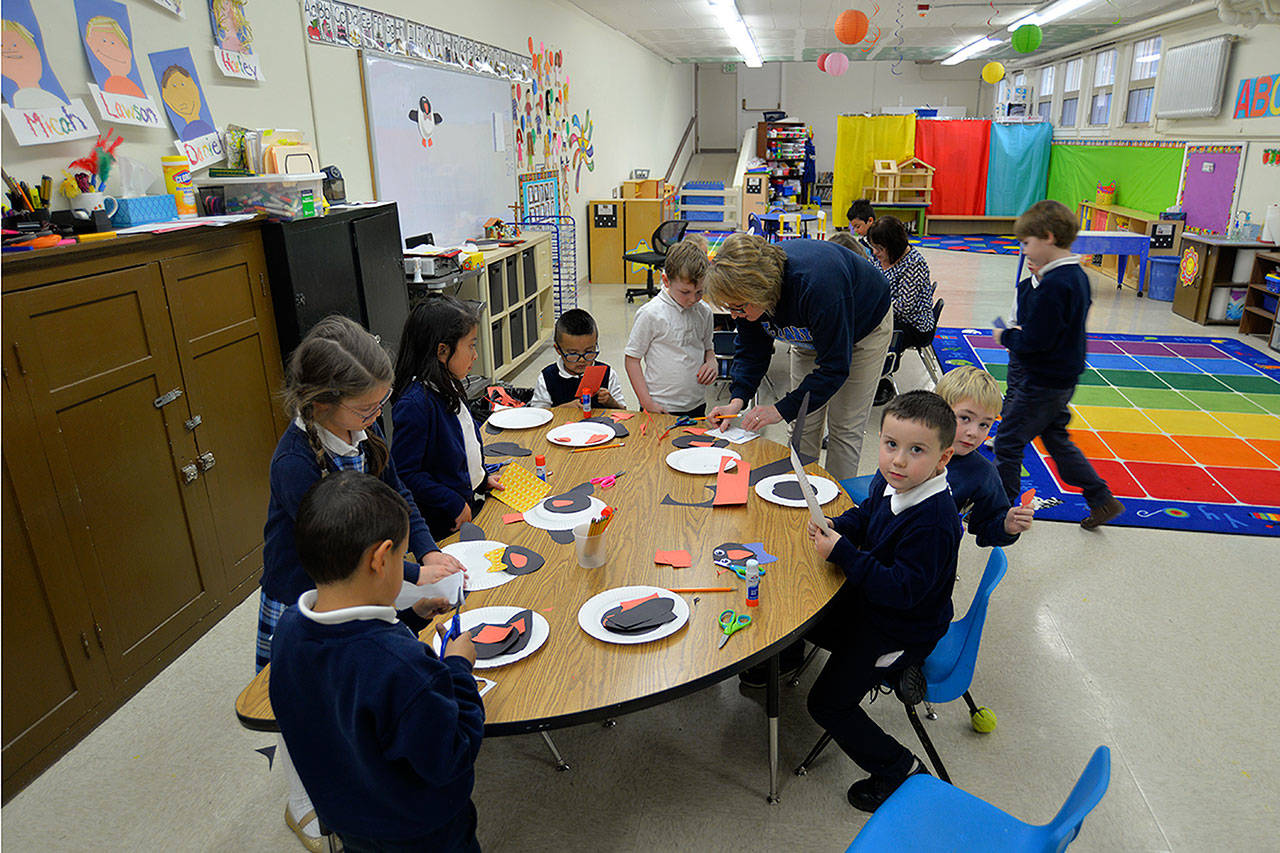Seated in the busy auditorium of St.Mary School in Aberdeen, second-grader Rigo Lemas is eating pizza and chatting with his mom and friends. It was the school’s special friends day last Wednesday, which encourages students to bring in parents for lunch, many of whom volunteer at the private Catholic school.
Lemas said he enjoys the school, and particularly likes art and math class, as well as the newly added robotics club after school. But he had a few rough spots before getting settled in at St. Mary.
He started in pre-kindergarten, not knowing English. His mom Amy says there weren’t as many Spanish-speaking students at the time. Then when Rigo was in kindergarten, his mom decided to move the family to Montana for eight months, where his dad was living, and Rigo had to attend a public school. Learning how to read in the bigger public school was a challenge for Rigo, his mom said. In order to return to the more one-on-one classrooms of St. Mary, Amy decided to move back to Aberdeen, and Rigo’s reading skills quickly improved.
“He was struggling to learn how to read. So we moved back to Aberdeen to get him back at St. Mary, to be in smaller classes,” said Amy. “… So we came back, and just within a month he was doing much better with his reading.”
St. Mary is one of Grays Harbor’s few private schools. It has been around since 1926 and currently serves 167 students from preschool to eighth grade. There is a 15-to-one ratio of students to teachers in the average class, which many of the parents say influenced their decision to send their kids. Paul Caraballo, whose two sons attend St. Mary, said he much prefers the smaller classes.
“My son had a hard time in public school, and there were too many students for one teacher, leading to miscommunications and things like that,” said Caraballo, whose son Michael is in fifth grade. “We decided to come here, and his teacher is just a super teacher, she helps him a lot. Plus they have half the students.”
Some parents also commented that St. Mary has a reputation for providing more rigorous academic classes.
“I can tell it’s rigorous because my son complains about too much homework,” said recently-added kindergarten teacher and student parent Lisa Villar.
For some extracurriculars like team sports and band class, the smaller St. Mary has to refer students to public schools, but they are working on upgrading to having a wider range of programs. This was the school’s first year offering Spanish class, and they offer an after school English as a Second Language class for English-learners (the student body is now 36 percent Latino). This spring, St. Mary will be opening a student-run garden on the playground, which they hope will grow food for school lunches and to feed the homeless.
Unlike public schools that receive a significant amount of state and federal funding, St. Mary relies on tuition, donations and fundraising efforts to fund itself. About a decade ago when the economy crashed, the school began offering more scholarships to families in need, and currently 83 percent receive need-based financial aid or scholarships through either the school or the Archdioceses of Seattle. Without any financial aid, one year of tuition for a student costs $4,845.
In order to ensure they are stable financially in future years, the school has undertaken an endowment campaign this year and donors have pledged to give more than $4.3 million over the next several years. Every teacher and staff member at the school has contributed. School officials said there are some major donors, but they prefer not to be named.
The worry isn’t that they will be facing closure anytime soon, but that the generous and wealthier people who have donated to the school are aging and aren’t going to be around to contribute forever. The school’s Advancement Director, Pete Scroggs, said potential life changes for some donors, such as moving out of Grays Harbor or beginning to support children in college are also reasons they decided to run this fundraiser that is proactively combating future financial struggle.
“The generation on the Harbor that has had the means to support the arts and other things, they’re aging,” said Scroggs. “That generation won’t be around forever, or will be moving out of the area, so we felt this was the great time to try and capitalize on the people who have supported the school for a long time. It gives them one more chance to make a permanent legacy-type gift.”
The school has a $6 million short-term goal to raise by the end of the school year to provide a larger financial cushion down the line, and a long-term goal of $10 million that would go toward future building and program needs. But they’ve already received enough to feel good about the campaign, and Scroggs said they will now broaden the fundraising focus throughout the community.
“The campaign is successful already, now it’s just about ‘come on and join us.’”



